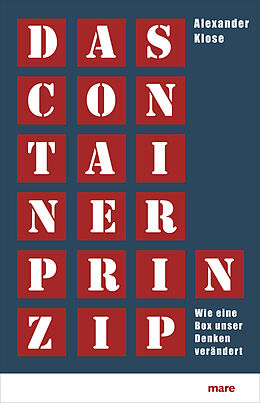Das Container-Prinzip Wie eine Box unser Denken verändert
|

|
 Diese Seite wurde seit 4 Jahren inhaltlich nicht mehr aktualisiert.
Unter Umständen ist sie nicht mehr aktuell.
Diese Seite wurde seit 4 Jahren inhaltlich nicht mehr aktualisiert.
Unter Umständen ist sie nicht mehr aktuell.
 Zusammenfassungen
Zusammenfassungen
 ls im Januar 2007 das in Seenot geratene Containerschiff MSC Napoli vor Cornwall einen Teil seiner Ladung verliert, gehen Bilder um die Welt, auf denen am Strand des kleinen Urlaubsortes Branscombe Massen von Menschen angespülte Stahlkisten plündern. Endlich einmal öffnen sich jene geheimnisvollen Black Boxes, deren Inhalt wir fast nie zu sehen bekommen: Motorräder, Keksdosen, Hundefutter, Schuhe, Autoersatzteile - ein Querschnitt durch die Gegenwart des globalen Konsumkapitalismus. Container sind das Medium der Globalisierung. Sie haben nicht nur eine umfassende Veränderung der Transportkultur auf See und an Land bewirkt, sondern maßgeblich zum Entstehen eines weltumspannenden Systems der Produktion und des Konsums beigetragen. Sie sind das Herzstück der modernen Logistik.
ls im Januar 2007 das in Seenot geratene Containerschiff MSC Napoli vor Cornwall einen Teil seiner Ladung verliert, gehen Bilder um die Welt, auf denen am Strand des kleinen Urlaubsortes Branscombe Massen von Menschen angespülte Stahlkisten plündern. Endlich einmal öffnen sich jene geheimnisvollen Black Boxes, deren Inhalt wir fast nie zu sehen bekommen: Motorräder, Keksdosen, Hundefutter, Schuhe, Autoersatzteile - ein Querschnitt durch die Gegenwart des globalen Konsumkapitalismus. Container sind das Medium der Globalisierung. Sie haben nicht nur eine umfassende Veränderung der Transportkultur auf See und an Land bewirkt, sondern maßgeblich zum Entstehen eines weltumspannenden Systems der Produktion und des Konsums beigetragen. Sie sind das Herzstück der modernen Logistik. We live in a world organized around the container. Standardized twenty- and forty-foot shipping containers carry material goods across oceans and over land; provide shelter, office space, and storage capacity; inspire films, novels, metaphors, and paradigms. Today, TEU (Twenty Foot Equivalent Unit, the official measurement for shipping containers) has become something like a global currency. A container ship, sailing under the flag of one country but owned by a corporation headquartered in another, carrying auto parts from Japan, frozen fish from Vietnam, and rubber ducks from China, offers a vivid representation of the increasing, world-is-flat globalization of the international economy. In The Container Principle, Alexander Klose investigates the principle of the container and ist effect on the way we live and think.
We live in a world organized around the container. Standardized twenty- and forty-foot shipping containers carry material goods across oceans and over land; provide shelter, office space, and storage capacity; inspire films, novels, metaphors, and paradigms. Today, TEU (Twenty Foot Equivalent Unit, the official measurement for shipping containers) has become something like a global currency. A container ship, sailing under the flag of one country but owned by a corporation headquartered in another, carrying auto parts from Japan, frozen fish from Vietnam, and rubber ducks from China, offers a vivid representation of the increasing, world-is-flat globalization of the international economy. In The Container Principle, Alexander Klose investigates the principle of the container and ist effect on the way we live and think.
Klose explores a series of "container situations" in their historical, political, and cultural contexts. He examines the container as a time capsule, sometimes breaking loose and washing up onshore to display an inventory of artifacts of our culture. He explains the "Matryoshka principle," explores the history of land-water transport, and charts the three phases of container history. He examines the rise of logistics, the containerization of computing in the form of modularization and standardization, the architecture of container-like housing (citing both Le Corbusier and Malvina Reynolds's "Little Boxes"), and a range of artistic projects inspired by containers. Containerization, spreading from physical storage to organizational metaphors, Klose argues, signals a change in the fundamental order of thinking and things. It has become a principle.
 Dieses Buch erwähnt ...
Dieses Buch erwähnt ...
 Personen KB IB clear | Ross Ashby , Erwin K. Bauer , Nicholas G. Carr , Paul N. Edwards , Thomas Friedman , Frank Hartmann , Mark Johnson , G. Lakoff , Marc Levinson , Niklas Luhmann , Neal Stephenson , Michael Weigend | |||||||||||||||||||||||||||||||||||||||||||||||||||||||||||||||||||||||||||||||||||||||||||||||||||
 Aussagen KB IB clear | Frachtcontainer haben die Globalisierung ermöglicht | |||||||||||||||||||||||||||||||||||||||||||||||||||||||||||||||||||||||||||||||||||||||||||||||||||
 Begriffe KB IB clear |  Frachtcontainer
, Frachtcontainer
,  Gegenwart Gegenwart present
, present
,  Globalisierung Globalisierung globalization
, globalization
,  Kapitalismus
, Kapitalismus
,  Standardisierung Standardisierung
| |||||||||||||||||||||||||||||||||||||||||||||||||||||||||||||||||||||||||||||||||||||||||||||||||||
 Bücher |
|
 Zitationsgraph
Zitationsgraph
 Zitationsgraph (Beta-Test mit vis.js)
Zitationsgraph (Beta-Test mit vis.js)
 Volltext dieses Dokuments
Volltext dieses Dokuments
 Anderswo suchen
Anderswo suchen 
 Beat und dieses Buch
Beat und dieses Buch
Beat hat dieses Buch während seiner Zeit am Institut für Medien und Schule (IMS) ins Biblionetz aufgenommen. Beat besitzt kein physisches, aber ein digitales Exemplar. (das er aber aus Urheberrechtsgründen nicht einfach weitergeben darf). Es gibt bisher nur wenige Objekte im Biblionetz, die dieses Werk zitieren.




















 , 3390 kByte)
, 3390 kByte)  Biblionetz-History
Biblionetz-History